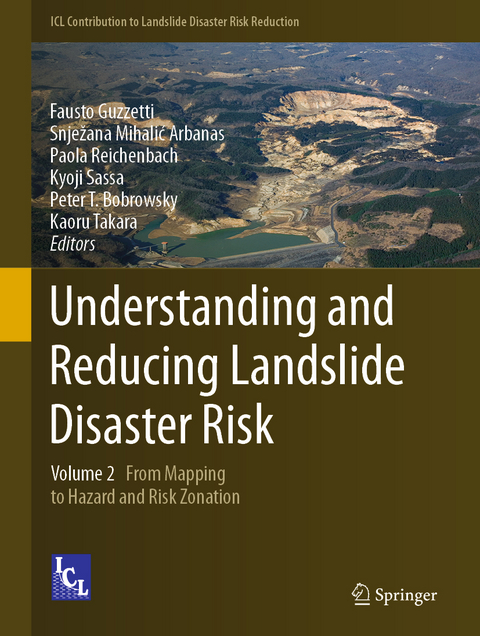
Understanding and Reducing Landslide Disaster Risk
Springer International Publishing (Verlag)
9783030602260 (ISBN)
This book is a part of ICL new book series "ICL Contribution to Landslide Disaster Risk Reduction" founded in 2019. Peer-reviewed papers submitted to the Fifth World Landslide Forum were published in six volumes of this book series. This book contains the followings:
-Keynotes
-Landslide detection, recognition and mapping
-Landslide susceptibility assessment and modelling
-Landslide size statistics and temporal modelling
-Data and information for landslide disaster mitigation
-Vulnerability to landslides of people, communities and the built environment
Dr. Fausto Guzzetti is General Director of Office III - Technical and Scientific Activities for Risk Forecasting and Prevention, Department of Civil Protection, Italian Presidency of the Council of Ministers, on leave from the Italian National Research Council.
Prof. Snjezana Mihalic Arbanas is a Full Professor of the Faculty of Mining, Geology and Petroleum Engineering of theUniversity of Zagreb, Croatia. She is the Chair of ICL Network Committee.
Paola Reichenbach is a Senior Researcher of the Research Institute for Geo-Hydrological Protection, an institute of the Italian National Research Council (IRPI-CNR), Perugia, Italy.
Prof. Kyoji Sassa is the Founding President and the Secretary-General of the International Consortium on Landslides (ICL). He has been the Editor-in-Chief of International Journal Landslides since its foundation in 2004.
Prof. Peter Bobrowsky is the President of the International Consortium on Landslides. He is a Senior Scientist of Geological Survey of Canada, Ottawa, Canada.
Prof. Kaoru Takara is the Executive Director of the International Consortium on Landslides. He is a Professor and Dean of Graduate School of Advanced Integrated Studies (GSAIS) in Human Survivability (Shishu-Kan), Kyoto University.
Kyenotes: Landslide Recognition and Mapping for Slope Disaster Risk Reduction and Management - Keynote Speech.- Landslide susceptibility mapping by interpretation of aerial photographs, AHP and precise DEM.- Landslide recognition and mapping: New landslide inventory map of the Sudetes Mountains (south-western Poland).- Gullies as landforms for landslide initiation - examples from the Dubracina River Basin (Croatia).- Opportunities and challenges of the object-oriented automatic landslide detection from the high resolution Digital Elevation Model.- Can Repeat LiDAR Surveys Locate Future Massive Landslides?.- Semi-automatic Landslide Inventory Mapping with Multiresolution Segmentation Process: A Case Study from Ulus District (Bartin, NW Turkey).- Landslide mapping based on UAV and SfM - Case study of the 2018 Prnjavor Cunticki landslide, Croatia.- Developing recognition and simple mapping by UAV/SfM for local resident in mountainous area in Vietnam - A case study in Po Xi Ngai Community, Laocai province.- Landslide activity classification based on Sentinel-1 satellite radar interferometry data.- Updating Landslide Activity State and Intensity by Means of Persistent Scatterer Interferometry.- Damming predisposition of river networks: a mapping methodology.- Landslides along Halong-Vandon Expressway in Quang Ninh province, Vietnam.- Landslide hazard assessment and zonation - susceptibility modelling: New data on geological conditions of landslide activity on Vorobyovy Gory (Moscow, Russia).- Impact of agricultural management in vineyards to landslides susceptibility in Italian Apennines.- Landslide susceptibility in two secondary rivers of La Ciénega watershed, Nevado de Toluca volcano, Mexico.- An Ordinal Scale Weighting Approach for Susceptibility Mapping Around Tehri Dam, Uttarakhand, India.- Potential Analysis of Deep-seated Landslides Caused by Typhoon Morakot Using Slope Unit.- Landslide susceptibility assessment using binary logistic regression in northern PhilippinesLandslide Hazard Mapping of Penang Island Malaysia based on Multilayer Perceptron Approach.- Landslide Susceptibility Mapping Based on the Deep Belief Network: A Case Study in Sichuan Province, China.- A Comparative study of deep learning and conventional neural network forevaluating landslide susceptibility using landslide initiation zones.- Landslide susceptibility assessment by ensemble-based Machine Learning models.- Application of Machine Learning Algorithms and Their Ensemble for Landslide Susceptibility Mapping.- Overcoming data scarcity related issues for landslide susceptibility modeling with machine learning.- Practical accounting of uncertainties in data-driven landslide susceptibility models. Examples from the Lanzhou case study.- Assessment of shallow landslides susceptibility using SHALSTAB and SINMAP at Serra do Mar, Brazil.- Regional slope stability analysis in landslide hazard assessment context, North Macedonia example.- Applying the Newmarkmodel in the assessment of earthquake triggered landslides during the 2017 Ms 7.0 Jiuzhaigou earthquake, China.- Evaluation of secondary landslide susceptibility for the rescue activity using LiDAR UAV data.- Methodology for landslides assessment causing river channel obstructions and the consequent water shortage in rural communities.- Landslide hazard assessment and zonation - temporal and size modelling: Landslide Size Distribution Characteristics of Cretaceous and Eocene Flysch Assemblages in the Western Black Sea Region of Turkey.- A statistical exploratory analysis of inventoried slide-type movements for South Tyrol (Italy).- Assessing landslide volume for landform hazard zoning purposes.- Empirical relationships to estimate the probability of runout exceedance for various landslide types.- Rapid sensitivity analysis for reducing uncertainty in landslide hazard assessment.- Applying debris flow simulation for detailed hazard and risk mapping.- Debris-Flow Peak Di
| Erscheinungsdatum | 25.12.2020 |
|---|---|
| Reihe/Serie | ICL Contribution to Landslide Disaster Risk Reduction |
| Zusatzinfo | XXIX, 505 p. 417 illus., 385 illus. in color. |
| Verlagsort | Cham |
| Sprache | englisch |
| Maße | 210 x 279 mm |
| Gewicht | 1629 g |
| Themenwelt | Naturwissenschaften ► Biologie ► Ökologie / Naturschutz |
| Naturwissenschaften ► Geowissenschaften ► Geologie | |
| Sozialwissenschaften ► Politik / Verwaltung ► Staat / Verwaltung | |
| Schlagworte | Assessing landslide vulnerability to people • Hazard assessment and zonation • ISDR-ICL Sendai Partnerships 2015-2025 • Kyoto 2020 Commitment • Landslide identification and mapping • Landslide Science • Land-use planning for landslide disaster mitigation |
| ISBN-13 | 9783030602260 / 9783030602260 |
| Zustand | Neuware |
| Informationen gemäß Produktsicherheitsverordnung (GPSR) | |
| Haben Sie eine Frage zum Produkt? |
aus dem Bereich


